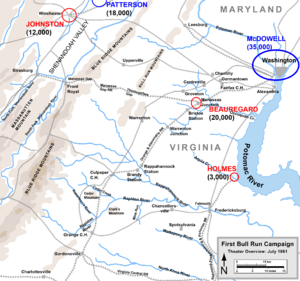Department of Pennsylvania facts for kids
Quick facts for kids Department of Pennsylvania |
|
|---|---|

Pennsylvania flag
|
|
| Active | April 27 - July 25, 1861 |
| Country | |
| Branch | |
| Type | Field Army |
| Engagements | American Civil War |
| Commanders | |
| Notable commanders |
Robert Patterson |
The Department of Pennsylvania was a large military group in the Union Army at the start of the American Civil War. It was also known as General Patterson's Army. This department was created on April 27, 1861. Its job was to protect and control areas in Pennsylvania, Delaware, and parts of Maryland.
This department was later combined with other military groups. On July 19, 1861, some of its parts joined the short-lived Department of the Shenandoah. Then, on August 24, it became part of the Department of the Potomac.
Contents
History of the Department
Major General Robert Patterson led the Department of Pennsylvania. Most of its soldiers were volunteers from Pennsylvania and New York. These soldiers signed up for three months of service.
The department had a small victory at the Battle of Hoke's Run on July 2. It also played a part, though indirectly, in the Union's loss at the First Battle of Bull Run on July 21. After these events, the remaining soldiers and their leaders joined the Department of the Shenandoah. This happened on July 25, 1861, under Major General Nathaniel P. Banks.
Pennsylvania's Special Troops
When President Abraham Lincoln asked for 75,000 volunteers in 1861, Pennsylvania offered more than twice its share. For political reasons, the U.S. Secretary of War, Simon Cameron, did not accept fifteen of these regiments right away. These groups became known as the 1st through 15th Pennsylvania Reserves.
Pennsylvania decided to keep, train, and equip these soldiers using its own money. This meant these fifteen regiments were not available for General Patterson or for the First Battle of Bull Run. Governor Andrew G. Curtin later told the State Legislature that eleven of these well-trained regiments were ready in Washington just four days after the Bull Run battle.
The Battle of Hoke's Run
On July 2, 1861, General Robert Patterson's army, the Department of Pennsylvania, crossed the Potomac River. They marched from Williamsport, Maryland, towards Martinsburg, Virginia. Near a place called Hoke's Run, Union soldiers met Confederate forces.
The Union troops slowly pushed the Confederates back towards Winchester. Colonel Thomas J. Jackson led the Confederate forces. He followed orders to slow down the Union advance, pulling back his smaller force. This fight was very quick. Only three regiments reported soldiers getting hurt: the First Wisconsin Infantry, the Eleventh Pennsylvania Infantry, and the Fifteenth Pennsylvania Infantry.
The First Battle of Bull Run
On the afternoon of July 21, 1861, the arrival of Brigadier General Joseph E. Johnston changed the course of the battle. His Confederate troops helped turn a Union victory into a major defeat. This loss quickly ended the North's hopes for a short war.
Lieutenant General Winfield Scott had hoped that Patterson's Department of Pennsylvania would stop Johnston from sending help to General Beauregard at Manassas Junction. When Johnston's troops played a big role in the battle, Patterson's actions became a topic of debate.
After the battle, Patterson explained his side of the story:
- He had asked General Scott for a direct order to attack Johnston but did not get one.
- He thought the battle at Manassas would happen on July 16, 1861. His job was to delay Johnston until that date.
- He believed he had successfully kept Johnston busy until July 16 and for several days after.
- He did not know the battle had not happened on July 16. He quickly told General Scott when Johnston actually left the Shenandoah Valley on July 20.
- His plans had been reviewed and approved by his officers, as he was told to do.
- He felt he had followed every direct order given to him.
Patterson was honorably discharged from the army on July 27, 1861. He never received another military position. He tried to correct the public record about his actions in many ways. This included meeting with President Abraham Lincoln and later publishing his own account of the events.
Later Years
The Department of Pennsylvania was brought back on December 1, 1864. This happened when the Department of the Susquehanna and the Department of the Monongahela joined together. It continued to operate until June 27, 1865, under the Middle Military Division.


